Which of the Following Best Describes a Typical Liberal Arts College


A liberal arts college or liberal arts institution of higher education is a higher with an accent on undergraduate study in liberal arts and sciences. Such colleges aim to impart a broad general cognition and develop general intellectual capacities, in dissimilarity to a professional, vocational, or technical curriculum.[1] Students in a liberal arts college generally major in a particular discipline while receiving exposure to a wide range of academic subjects, including sciences as well every bit the traditional humanities subjects taught as liberal arts. Although it draws on European antecedents,[ii] the liberal arts higher is strongly associated with American higher educational activity, and most liberal arts colleges around the globe draw explicitly on the American model.
There is no formal definition of liberal arts higher, just one American authority defines them as schools that "emphasize undergraduate instruction and award at least half of their degrees in the liberal arts fields of study."[3] Other researchers have adopted similar definitions.[iv]
Although many liberal arts colleges are exclusively undergraduate, some also offer graduate programs that atomic number 82 to a master's degree or doctoral caste in subjects such as business assistants, nursing, medicine, and law. Similarly, although the term "liberal arts higher" most usually refers to an contained establishment, information technology may besides sometimes refer to a academy college within or affiliated with a larger academy. Virtually liberal arts colleges exterior the United States follow this model.
Distinguishing characteristics [edit]
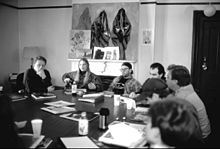
Liberal arts colleges are distinguished from other types of higher education chiefly by their generalist curricula and small size. These attributes have diverse secondary furnishings in terms of administration as well as student feel.[5] For example, class size is usually much lower at liberal arts colleges than at universities, and faculty at liberal arts colleges typically focus on teaching more than research.[half-dozen]
From a student perspective, a liberal arts college typically differs from other forms of higher teaching in the post-obit areas: higher overall student satisfaction, a general feeling that professors take a personal involvement in the student's instruction, and perception of encouragement to participate in discussion.[vii] Many students select liberal arts colleges with precisely this sense of personal connection in heed.[7]
From an administrative standpoint, the small size of liberal arts colleges contributes to their cohesion and ability to survive through difficult times.[8] Job satisfaction is likewise typically higher in liberal arts colleges, for both faculty and staff.[9] The smaller size also makes it feasible for liberal arts colleges to adopt relatively experimental or divergent approaches, such every bit the Great Books curriculum at St. John's or Shimer, or the radically interdisciplinary curriculum of Marlboro.
In addition, most liberal arts colleges are primarily residential,[ commendation needed ] which means students live and larn away from habitation, often for the first time.
The distinctiveness of these attributes is somewhat eroded past the tendency of universities to adopt aspects of the liberal arts college, and vice versa.[10] For example, several American universities, including the University of California'due south campuses in Santa Cruz and San Diego, have experimented with a cluster colleges model in which pocket-size liberal-arts-college-like units within a larger university course a "honeycomb of residential colleges".[11] In addition, some universities have maintained a sub-unit of measurement that preserves many aspects of the liberal arts college, such as Columbia College within Columbia University.[10]
Liberal arts colleges themselves sometimes cluster to offer greater curricular breadth or share other resources (for instance Colgate Academy and Hamilton Higher in New York allow cross enrollment).[12]
Liberal arts and liberal arts higher [edit]
In academia, liberal arts generally refer to subjects or skills that aim to provide general knowledge and comprise the arts, humanities, natural sciences, and social sciences (rather than professional person or technical skills).[13] Most liberal arts colleges, however, also offer courses in subjects that are not traditionally considered part of the liberal arts, such as computer science.[14]
Globally [edit]
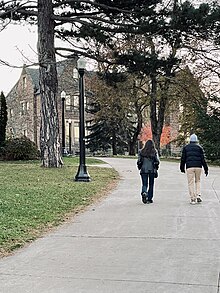
Mountain Allison has been ranked the acme undergraduate university in Canada by Maclean'due south magazine's almanac University Rankings more than times than whatever other university in the nation.[15]
Liberal arts colleges are found in all parts of the world. Notwithstanding the European origins of the concept of liberal arts education,[two] today the term is largely associated with the United States, and virtually self-identified liberal arts colleges worldwide are built on the American model.[16] The Global Liberal Arts Alliance, which incorporates institutions on five continents, refers to itself as "an international, multilateral partnership of American style liberal arts institutions."[17]
In 2009, liberal arts colleges from around the world formed the Global Liberal Arts Alliance, an international consortium and "matching service" to help liberal arts colleges in different countries bargain with their shared problems.[18]
In N America [edit]
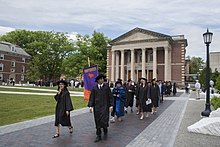
Williams College is i of the top ranked liberal arts college in the Usa[19]
The liberal arts college model took root in the United states of america in the 19th century, as institutions spread that followed the model of early on schools like Harvard, Yale, and Dartmouth, although none of these early American schools are regarded every bit liberal arts colleges today.[20] These colleges served as a means of spreading a basically European cultural model beyond the new country.[20] The model proliferated in the 19th century; some 212 small liberal arts colleges were established between 1850 and 1899.[21] As of 1987, there were nearly 540 liberal arts colleges in the United States.[4]
The oldest liberal arts higher in America is considered to be Washington Higher, the outset college chartered after American independence. Other prominent examples in the United States include the so-called Little Ivy colleges in New England, the surviving predominantly female Vii Sisters colleges along the northeastern seaboard, the Claremont Colleges in Southern California, and the Ohio 5, but similar institutions are found all over the country. Most are private institutions, but a scattering of public liberal arts schools exist (such as the Academy of Mary Washington in Fredericksburg, Virginia).
Co-ordinate to U.S. News & Earth Report, the top x ranked Liberal Arts Colleges in America for 2020, by alphabetical order, are: Amherst Higher, Bowdoin College, Carleton College, Claremont McKenna College, Hamilton College, Middlebury College, Pomona Higher, Swarthmore College, the Us Naval University, Washington & Lee University, Wellesley College, and Williams College.[19]
Liberal arts colleges are too found in Canada, including Acadia University, Bishop's University, Mountain Allison University, Trent University, and St. Francis Xavier Academy.
In South America [edit]
The leading arrangement is the National Constitute of Educators of Liberal Arts and Creative Teaching "Instituto Nacional Superior del Profesorado" located in Buenos Aires, Argentina. From 1983 to 2013 the institute was part of the IUNA National University Found for the Arts, and since 2014, the Ruanova Found of Performing Arts and Higher Education became part of the UNA Universidad Nacional de las Artes, (UNA) National University of the Arts[22] [23] The Ministry building of Culture also released a DVD on the life and artistic work of various creators including the dancer María Ruanova.[24]
In Europe [edit]

With the exception of pioneering institutions such as Franklin University Switzerland, established as a Europe-based, Us-style liberal arts college in 1969, Saint Louis University Madrid Campus, established in 1967, and Richmond, The American International University in London, established in 1972[25] only recently take efforts been fabricated to import the American liberal arts college model to continental Europe.
In the Netherlands, universities have opened constituent liberal arts colleges under the terminology "university college" since the late 1990s. This tendency was spearheaded by Dutch sociologist Hans Adriaansens, who was "frustrated with the big-scale climate of academy education in the netherlands".[26] Dutch academy colleges of this kind include Leiden University Higher The Hague, University College Utrecht, University College Maastricht, Amsterdam University College, University College Roosevelt, Erasmus University College, University College Groningen and University College Tilburg.
Other liberal arts colleges in continental Europe include Bratislava International School of Liberal Arts in Slovakia, Jacobs Academy Bremen, Bard Higher Berlin, the Leuphana University of Lüneburg with their Available program Studium Individuale and the University College Freiburg in Germany. Bard Higher Berlin was founded in Berlin in 1999 as the European Higher of Liberal Arts,[27] and in 2009 it introduced a 4-year Bachelor of Arts program in Value Studies taught in English and leading to an interdisciplinary degree in the humanities.[28]
Although liberal arts colleges equally such remain rare, liberal arts caste programs are beginning to establish themselves in Europe. For example, Academy College Dublin offers the degree, as does St. Marys University College Belfast, both institutions coincidentally on the isle of Republic of ireland. In 2010 the University of Winchester introduced its Modernistic Liberal Arts[29] undergraduate program, the kickoff of its kind in the Uk. In 2012, Academy College London began its interdisciplinary Arts and Sciences BASc caste (which has kinship with the liberal arts model) with 80 students.[xxx] Male monarch'southward College London launched the BA Liberal Arts, which has a slant towards arts, humanities and social sciences subjects.[31] The New Higher of the Humanities also launched a new liberal educational activity programme. The 4-twelvemonth bachelor's degree in Liberal Arts and Sciences at Academy College Freiburg is the first of its kind in Deutschland. Information technology started in October 2012 with 78 students.[32] The first Liberal Arts caste program in Sweden was established at Gothenburg University in 2011,[33] followed by a Liberal Arts Available Programme at Uppsala University'southward Campus Gotland in the autumn of 2013.[34] Liberal arts colleges in Italy include John Cabot Academy and The American University of Rome in Rome. The University College of N Staffordshire, founded in 1950 in the Uk, was frequently referred to as the "Keele Experiment" because of its innovative curriculum and emphasis on a scholarly community resident together on campus. The college became Keele Academy in 1962 and continues to reflect many features of the liberal arts college model. It has been described every bit the closest example of a liberal arts college in the United kingdom of great britain and northern ireland. This distinctiveness will be reinforced with the opening of the new Keele Plant of Liberal Arts and Sciences in 2016.
From September 2016 Chavagnes Studium, a Liberal Arts centre in France volition be offering a 2-twelvemonth intensive BA in the Liberal Arts with a distinctively Catholic perspective.[35]
In Asia [edit]

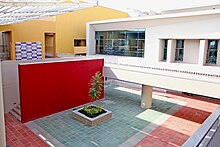
Lingnan Academy in Hong Kong was established as a liberal arts college in the early 20th century, although it later on became a total-fledged academy. Ginling College in Nanjing similarly followed the model of an American liberal arts college from its founding in 1915 until forced to suit with the Nationalist educational organization in the 1930s.[36] In Zhuhai Urban center, Hong Kong Baptist University and Beijing Normal Academy opened United International College, which adopted the liberal arts higher education system.
International Christian University in Tokyo, which opened in 1953, defines itself as "Japan'south first liberal arts college."[37]
Yale-NUS College was started in 2011 as Singapore'due south first liberal arts college as a collaboration between Yale Academy in the United States and the National University of Singapore.[38] It attracted controversy over concerns that Yale was compromising on its liberal values by opening a college in a land where there are stiff curbs on freedom of speech and associates, with Yale faculty members expressing their "business regarding the history of lack of respect for civil and political rights in the state of Singapore".[39] In response, many existing faculty and students accept noted that there has been picayune repression of freedom of expression at the college and that it provides a slap-up opportunity to promote the liberal arts in Asia.[40] In August 2021, NUS announced the closure of Yale-NUS Higher, with the Grade of 2025 being the terminal cohort to receive an NUS degree. It will exist replaced by 'New Higher', a merger between Yale-NUS College and the NUS Academy Scholars Program.
Kalayaan College in the Philippines is one of the all-time examples of a liberal arts college in the country. Located in the New Manila district of Quezon City, information technology was founded in 2000 past former educators from the University of the Philippines led by Dr. José Abueva, President of the University from 1987 to 1993 and current Chairman of the KC Lath of Trustees. It offers the same kind of education provided past UP to qualified students who are unable to enter the land'due south premier state university considering of its limited college quotas.[41] The curriculum and grading organisation are patterned after the academic programs and the grade construction offered by the University of the Philippines and is composed of administrators and kinesthesia members who graduated from Up, and/or are besides members of the UP academic community.[42]
Sogang University was founded as South Korea's first liberal arts college. In 1960, Jesuits founded Sogang College. Although, it became Sogang University in 1970, it is nevertheless following model of American liberal arts higher in many aspects. [43] Seoul National University in Republic of korea established the College of Liberal Studies in 2007, initially as an educational project. Yet, afterward being established as a proper college in the SNU, it has become the merely college that allows students to create their own major.[44]
Liberal arts colleges in South asia include Ajeenkya DY Patil University in Pune, Bharat, Forman Christian College in Lahore, Pakistan, Habib University in Karachi, Pakistan and FLAME University in Pune, Maharashtra, India, referred to as India's 'showtime college of Liberal Education'.[45] The University is a member of the Global Liberal Arts Brotherhood[46] has also recently signed a Memorandum of Understanding (MoU) with Nuffield College, Academy of Oxford.[47]
Also, Ahmedabad University, a private,[48] non-profit university offers its students a liberal education which is focused on research and interdisciplinary learning[49] .

Baghdad Higher has offered a liberal arts curriculum since the early on 20th century, only despite its name it has never offered more than a high school education.[ commendation needed ] Effat University in Saudi Arabia, a women's establishment, is a fellow member of the Global Liberal Arts Alliance.[ citation needed ] Israel's first liberal arts higher, Shalem College, was established in 2013.[50]
In Africa [edit]
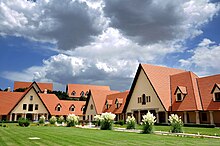
Three institutions in Africa are members of the Global Liberal Arts Brotherhood: Al Akhawayn University in Morocco, American Academy of Cairo in Egypt, and American University of Nigeria. The Egyptian and Nigerian schools are universities with a liberal arts component, only Al Akhawayn was founded on the model of an American liberal arts higher.
Ashesi University is a liberal arts college located in Berekuso, Ghana, established in 2002. The school's president, Patrick Awuah, described the schoolhouse'due south mission as "educating a new generation of leaders in Africa who call back ethically and who are problem solvers and have the power and the want to confront problems on the continent."[51]
In Australia [edit]
Campion College is a Roman Cosmic dedicated liberal arts higher located in the western suburbs of Sydney. Founded in 2006, it is the first third educational liberal arts college of its kind in Australia. Campion offers a Bachelor of Arts in the Liberal Arts equally its sole undergraduate degree. The key disciplines studied are history, literature, philosophy and theology.
The Millis Institute is the Schoolhouse of Liberal Arts at Christian Heritage Higher located in Brisbane. It offers a Bachelor of Arts in Liberal Arts in which students can cull to major in Philosophy, Theology, History or Literature.
A new Schoolhouse of Liberal Arts has been formed in the University of Wollongong; the new Arts course entitled 'Western Civilisation' was beginning offered in 2020. The interdisciplinary curriculum focuses on the classic intellectual and artistic literature of the Western tradition. Courses in the liberal arts have also been developed at the University of Sydney and University of Notre Dame.
Lists of schools [edit]
- List of liberal arts colleges
- List of liberal arts colleges in the United States
Run across also [edit]
- Liberal arts education
- Bachelor of Liberal Arts
- College of Arts and Sciences
- Liberal arts colleges in the United States
References [edit]
- ^ "Liberal Arts: Encyclopædia Britannica Concise". Encyclopædia Britannica. Archived from the original on 2008-02-15.
- ^ a b Harriman 1935.
- ^ "National Liberal Arts Colleges Rankings". US News & World Report. Archived from the original on 2016-08-21. Retrieved 2015-01-08 .
- ^ a b Clemmer 1997, p. 73.
- ^ Bonvillian 1996, pp. 29–30. sfn error: no target: CITEREFBonvillian1996 (help)
- ^ Clemmer 1997, p. 78.
- ^ a b Bonvillian 1996, p. 30. sfn error: no target: CITEREFBonvillian1996 (help)
- ^ Bonvillian 1996, p. 29. sfn error: no target: CITEREFBonvillian1996 (help)
- ^ Clemmer 1997, p. 77.
- ^ a b Thelin 2004, p. 295.
- ^ Thelin 2004, pp. 295–296.
- ^ "Cross-Registration Guidelines" (PDF) . Retrieved Dec 28, 2020.
- ^ "the definition of liberal arts". Dictionary.com. Archived from the original on 2016-x-17. Retrieved 2016-x-21 .
- ^ Cech, Thomas (2000). Distinctively American: The Residential Liberal Arts Colleges . Transaction Publishers. ISBN0765807211.
- ^ "Mount Allison University: Tuition and Profile". Macleans.ca . Retrieved 2022-03-fifteen .
- ^ Redden, Elizabeth (2009-02-16). "The Liberal Arts, Abroad". Inside Higher Ed. Archived from the original on 2015-01-ten. Retrieved 2015-01-08 .
- ^ "Global Liberal Arts Alliance". Archived from the original on 2015-01-09. Retrieved 2015-01-08 .
- ^ Redden, Elizabeth (2009-04-06). "A Global Liberal Arts Brotherhood". Inside Higher Ed. Archived from the original on 2015-01-10. Retrieved 2015-01-08 .
- ^ a b "2021 All-time National Liberal Arts Colleges". Retrieved December 28, 2020.
- ^ a b Bonvillian 1996, p. 21. sfn mistake: no target: CITEREFBonvillian1996 (help)
- ^ Bonvillian 1996, p. 23. sfn error: no target: CITEREFBonvillian1996 (help)
- ^ "MARIANELA NÚÑEZ: PREMIO MARÍA RUANOVA - En su país reconocen su trayectoria". 7 June 2011.
- ^ "Historia". Retrieved ii March 2014.
- ^ "Historia general de la danza Argentine republic". Retrieved ii March 2014.
- ^ "About Franklin". Franklin University Switzerland Official Spider web Site. Franklin University Switzerland. Archived from the original on 2014-04-08. Retrieved 2014-07-03 .
- ^ Lessem, Ronnie; Schieffer, Alexander (2014). Integral Development: Realising the Transformative Potential of Individuals. p. 478. ISBN9781409423539.
- ^ "Berlin's sturdiest ivory tower". Expatica.com. Archived from the original on 17 December 2013. Retrieved 26 Baronial 2013.
- ^ "Germany: New approach to liberal studies". Universityworldnews.com. xv March 2009. Retrieved 26 August 2013.
- ^ "BA (Hons) Modern Liberal Arts". University of Winchester. Archived from the original on 25 May 2017. Retrieved 26 Baronial 2013.
- ^ "Arts and Sciences (BASc) programmes". University College London. Archived from the original on 29 September 2013. Retrieved 26 August 2013.
- ^ "KCL - About Liberal Arts". Archived from the original on 7 January 2014. Retrieved fifteen January 2014.
- ^ "Liberal Arts and Sciences Program (LAS)". University College Freiburg. Archived from the original on 20 August 2013. Retrieved 26 August 2013.
- ^ "Liberal Arts, Gothenburg Academy". Flov.gu.se. 22 May 2013. Archived from the original on 2 November 2013. Retrieved 26 Baronial 2013.
- ^ "Liberal Arts Program at Uppsala Academy". uu.se. Archived from the original on 30 June 2017. Retrieved 29 April 2018.
- ^ "Archived copy". Archived from the original on 2015-10-03. Retrieved 2015-10-01 .
{{cite spider web}}: CS1 maint: archived copy as title (link) - ^ Feng, Jin (2010). The Making of a Family Saga: Ginling College. p. 247. ISBN9781438429120.
- ^ Hibiya, Junko. "A Message from the President: Looking Into 'Bug of Living'". International Christian University. Archived from the original on 2015-01-08. Retrieved 2015-01-08 .
- ^ "404 - URL invalid" (PDF). Archived (PDF) from the original on 2016-03-04. Retrieved 2015-03-10 .
- ^ "Yale opens controversial higher in Singapore". Archived from the original on 2015-04-03. Retrieved 2015-03-10 .
- ^ Simon, Stephanie (29 December 2012). "Yale under burn down for new campus in restrictive Singapore". Reuters. Archived from the original on 27 August 2016. Retrieved 23 November 2016.
- ^ "How to get a virtual Upwardly education - Philstar.com". philstar.com. Archived from the original on three July 2017. Retrieved 29 April 2018.
- ^ "Archived copy". Archived from the original on 2015-09-24. Retrieved 2015-08-04 .
{{cite web}}: CS1 maint: archived copy as title (link) - ^ veritas-a.com (in Korean) http://www.veritas-a.com/news/articleView.html?idxno=45783. Retrieved 2021-08-06 .
- ^ "History". cls.snu.ac.kr (in Korean). Retrieved 2021-06-28 .
- ^ "Experts focus on higher instruction, institution building in Republic of india". afternoondc.in. Archived from the original on 23 Nov 2016. Retrieved 23 Nov 2016.
- ^ "Member in the Global Liberal Arts Alliance". liberalartsalliance.org. Archived from the original on 25 May 2017. Retrieved 23 November 2016.
- ^ "FLAME University Announces Collaboration with Nuffield Higher in the University of Oxford, England". Business Wire India. The Telegraph. Archived from the original on eighteen Oct 2016. Retrieved 23 Nov 2016.
- ^ "Fiscal Express". Archived from the original on 2017-12-30.
- ^ "Ahmedabad Academy Website". Archived from the original on 2017-12-28.
- ^ Melanie Lidman (13 January 2013). "State of israel accredits first liberal arts college". Jerusalem Post. Retrieved 11 February 2022.
- ^ Redden, Elizabeth (2007-10-19). "A Liberal Arts College Marks 5 Years in Ghana". Inside Higher Ed. Archived from the original on 2015-01-10. Retrieved 2015-01-08 .
Works cited [edit]
- Bonvillian, Gary; Murphy, Robert (1996). The Liberal Arts Higher Adapting to Modify: The Survival of Pocket-size Schools (2014 ebook ed.). ISBN9781135589332.
- Clemmer, Joel (1997). "The Liberal Arts College Library Director and the Collegiate Myth". In Dandraia, Frank (ed.). The Academic Library Director: Reflections on a Position in Transition (2013 ebook ed.). Routledge. ISBN9781134755042.
- Harriman, Philip (1935). "Antecedents of the Liberal Arts College". The Journal of Higher Education. half-dozen (two): 63–71. doi:x.2307/1975506. JSTOR 1975506.
- Thelin, John R. (2004). A History of American Higher Teaching . Johns Hopkins Academy Press. ISBN0801878551.
Further reading [edit]
- Morris, Edward. The Lindenwood Model: An Antidote for What Ails Undergraduate Education. Academy Press (2007)
- Pfnister, Allen O. "The Role of the Liberal Arts College." The Journal of Higher Instruction. Vol. 55, No. 2 (March/April 1984): 145–170.
- Reeves, Floyd W. "The Liberal-Arts College." The Journal of College Education. Vol. 1, No. 7 (1930): 373–380.
- Seidel, George. "Saving the Pocket-sized College." The Journal of College Education. Vol. 39, No. six (1968): 339–342.
External links [edit]
- Global Liberal Arts Alliance
- Council of Public Liberal Arts Colleges
- Consortium of Liberal Arts Colleges
- How many (U.Southward.) colleges and universities accept airtight since 2016? A list maintained by Educational activity Drive and updated in real fourth dimension.
Source: https://en.wikipedia.org/wiki/Liberal_arts_college
0 Response to "Which of the Following Best Describes a Typical Liberal Arts College"
Post a Comment